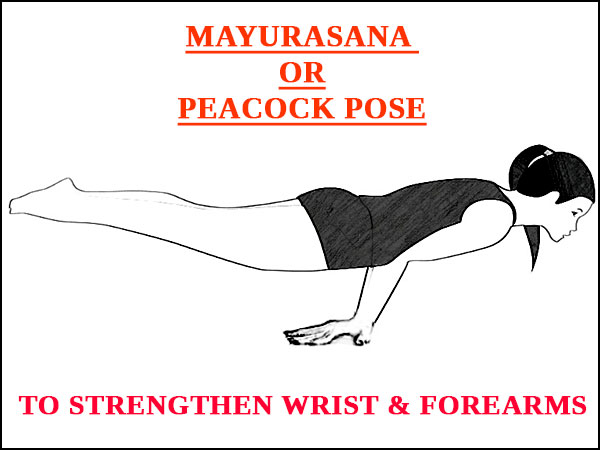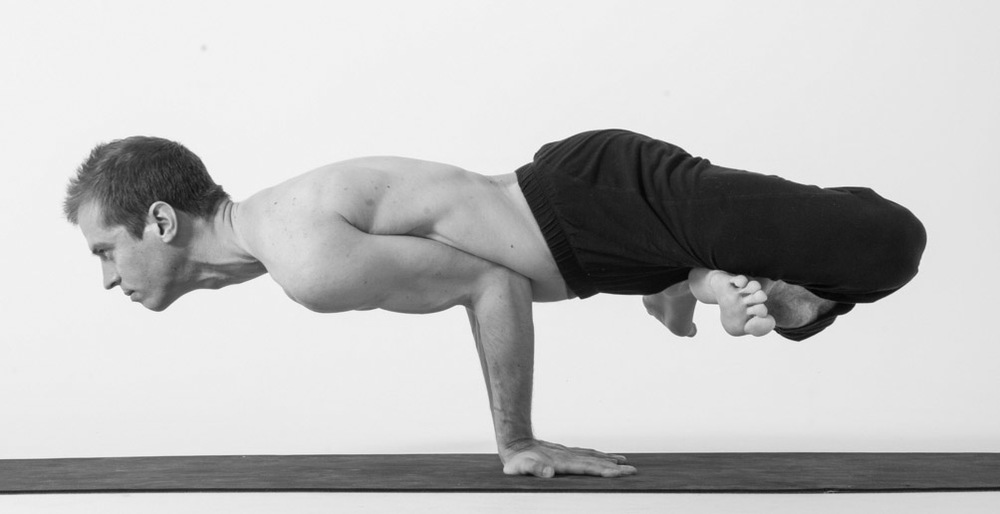
20 Dec 2020 HYN Himalayan Yoga Academy
“Paanyo-stalaabhyaama-valambya Bhoomim Tatkoor-parasthaa-pitanaabhipaarshvam;
Uchchaasano dandavadutthitah khe maayoora-metatpra-vadanti Peetham!!”-2. 30
Keeping the palms of both hands firmly on the floor, place both elbows to the rear on each side of the navel. Then raise both the legs and body like a stick. This is called Mayurasana.
Introduction
Mayurasana (Peacock pose) is a hand-balancing asana in Hatha Yoga and modern yoga as exercise with the body held horizontal over the hands. It is one of the oldest non-seated asanas.
Sanskrit: मयूरासन; Mayur – Peacock, Asana – Pose; Pronounced As – my-yer-ahs-anaa
According to the Yogic texts, the peacock symbolizes love and immortality. This asana is said to resemble a peacock when it struts around with its feathers down. The Peacock Pose has a whole lot of benefits, and although it looks complicated, with a little practice, it is quite easy to do. Mayurasana is an advanced arm-balancing asana that tones and detoxifies the body, promotes mental health, and energizes the solar plexus chakra.
The Science of Mayurasana
A brief look at this asana might make you think that you need tremendous arm strength to do it right. However, the most important strength that you would have to master is to learn how to work with your belly. Like any other form of arm-balancing pose, you must develop incredible strength to practice it correctly. However, you should also develop patience along with strength because it is the only continuous practice that will help you to attain a relationship with the force of gravity, which you must develop to perform Mayurasana successfully.
The other thing that you will have to do is learn how to consider the arms as legs and then push the elbows right into your belly. While this might get rather uncomfortable initially, with practice, you can do this perfectly and benefit from it. As you use your hands as legs for your body, you will find that your abdominal muscles effectively strengthen under the abs. Such strength is going to provide you with stability as you do the pose. This asana also arouses kundalini, encouraging it to move through the body.
How to Do Mayurasana
- For practice the Peacock pose, first of you need a yoga mat.
- Create a kneel position onto the yoga mate and make sure your heel should stand as you can sit on it. Keep your knees are wide apart.
- Place your hands flat on the floor with your fingertips facing your body, and press the palms into the floor.
- Bend your elbows slightly to a right angle. Rest the front torso on the upper arms, and sides of the navel on the elbows.
- Push your stomach down onto your elbows and Lower your forehead to the floor.
- Straighten your knee, stretch out your both legs behind you.
- Lift your head off the floor.
- In this position, raise your whole body, balanced by the elbows on the abdomens muscles and the weight entirely on the palms.
- Breathe evenly for three or five breaths, or about ten seconds. As you practice, you can gradually increase this time up to fifty seconds.
- To come out from this pose slowly lower your head and feet to the floor, bend your knees, and lift your torso off your arms. And rest in Balasana (Child Pose) and Adho Mukha Svanasana (Downward Facing Dog).
Beginner’s Tip
As a beginner, you might find it hard to balance yourself in this asana. To get the asana right, use blocks to support your head and ankles till you get a hang of the asana.
Preparatory Poses Associated with Mayurasana
The main preparatory poses that you need to do for Mayurasana are stated below:
Eka Pada Sirsasana, Chaturanga Dandasana
Follow-up poses for Mayurasana
These are the follow-up poses that you need to do after Mayurasana are as below:
Adho Mukha Svanasana, Bhujapidasana, Baalaasana, Dwi Hasta Bhujasana, Eka Hasta Bhujasana, Visvamitrasana
Benefits of Mayurasana (Peacock Pose)
Mayurasana offers a wide range of health benefits. It strengthens the arms, tones abdominal organs, improves digestion, boosts energy, and is an excellent detoxifier. This asana promotes mental health as well. In spiritual practice, mayurasana activates the manipura (solar plexus) chakra, which governs vitality, balance, and strength. This chakra is associated with self-esteem, willpower, and spiritual ascent.
- Mayurasana manage the blood circulation.
- It improves concentration and boost immunity.
- Mayurasana will provide an additional challenge for detoxifies the body.
- It also alleviates the symptoms of constipation.
- It also natural cures for diabetes.
- Mayurasana is more beneficial in toning the digestive system
- It helps to get rid of tumors and fevers.
- This asana helps to make the wrist, shoulders, elbows, and spine stronger.
- It helps to improve body posture.
- The Gheranda Samhita says that the Peacock Pose cancels toxins. It detoxifies the body and also helps to get rid of tumors and fevers.
- It helps tone the digestive organs and increases blood circulation in the abdominal area, therefore making it stronger.
- This asana energizes the pancreas, stomach, liver, spleen, kidneys, and intestines.
- Mayurasana tones the abdominal muscles and strengthens the abdominal organs of spleen, gallbladder, liver, and kidney.
- It also stimulates Manipura Chakra because Manipura chakra is located the navel, when the elbows pressed in the navel, the Manipura chakra gets activated.
- It also improves sexual activity.
- Mayurasana also calms the mind, promotes a sense of calm, and improves focus.
- It reduces stress and alleviates depression.
Precautions of Mayurasana
- The Peacock Pose or Mayurasana is not recommended for people who have medical conditions like Hypertension, Cardiac, Hernia, Eye, ear, nose infections, Problems in the intestine, Menstruation, and Pregnancy.
- Women in the perimenopausal phase or even during the menopause must avoid practice this pose.
- Those are suffering from lower backache should avoid this asana.
- Pregnant women should not carry out this pose because of the excess belly weight and the forward movement. It can lead to complications.
- This asana is said to detoxify your system and release toxins. If you feel unwell during the pose, release the asana immediately.
Advanced Pose Variations

To intensify the pose, you could try the Pincha Mayurasana or the Feathered Peacock Pose, Padma-mayurasana. It is done as a culmination of all the elements to get your forearm balance right.
If you wanna learn this pose, then join the online session of Swami Yog Subodh (The main yoga guru of Himalayan Yoga Academy).
